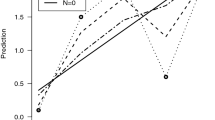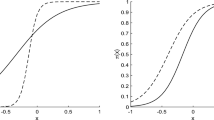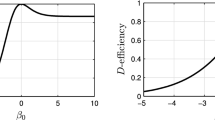Abstract
We introduce here the compound optimal design strategy to determine the Best Linear Unbiased Estimates (BLUEs) of location and scale parameters based on suitably chosen few order statistics. It is shown that the linear estimates of the parameters from any location-scale distribution, based on few optimally chosen ranks, obtained from the compound optimal design criterion is indeed the BLUE. Further extension of the strategy to Asymptotically Best Linear Unbiased Estimates (ABLUEs) is also discussed. The validation of the proposed strategy is justified through a numerical study for normal, Laplace and logistic distributions. Finally, a real-life data set is analyzed to illustrate the proposed strategy.


Similar content being viewed by others
References
Arnold BC, Balakrishnan N, Nagaraja HN (1992) A first course in order statistics. John Wiley & Sons, New York
Atkinson AC, Bogacka B (1997) Compound D- and Ds-optimum designs for determining the order of a chemical reaction. Technometrics 39:347–356
Bain LJ, Engelhardt M (1973) Interval estimation for the two parameter double exponential distribution. Technometrics 15:875–887
Balakrishnan N, Cohen AC (1991) Order statistics and inference: estimation methods. Academic Press, Boston
Balakrishnan N, Rao CR (1997) A note on the best linear unbiased estimation based on order statistics. The American Statistician 51:181–185
Balakrishnan N, Govindarajulu Z, Balasubramanian K (1993) Relationships between moments of two related sets of order statistics and some extensions. Ann Inst Stat Math 45:243–247
Bhattacharya R (2020) Implementation of compound optimal design strategy in censored life-testing experiment. TEST 29:1029–1050
Bhattacharya R, Saha BN, Farías GG, Balakrishnan N (2020) Multi-criteria based optimal life-testing plans under hybrid censoring scheme. TEST 29:430–453
Chan LK, Chan NN (1973) On the optimum best linear unbiased estimates of the parameters of the normal distribution based on selected order statistics. Scand Actuar J 2:120–128
Chan LK, Cheng SW (1982) The best linear unbiased estimates of parameters using order statistics. Soochow Journal of Mathematics 8:1–13
Chan LK, Cheng SW (1988) Linear estimation of the location and scale parameters based on selected order statistics. Communications in Statistics - Theory and Methods 17:2259–2278
Cook RD, Wong WK (1994) On the equivalence of constrained and compound optimal designs. J Am Stat Assoc 89:687–692
Govindarajulu Z (1963) Relationships among moments of order statistics in samples from two related populations. Technometrics 5:514–518
Gupta SS, Balakrishnan N (1992) Logistic order statistics and their properties. In: Balakrishnan N (ed) Handbook of logistic distribution, pp 17–48. Marcel Dekker, New York
Harter HL (1961) Estimating the parameters of negative exponential populations from one or two order statistics. The Annals of Mathematical Statistics 32:1074–1090
Harter HL (1971) Some optimization problems in parameter estimation. In: Rustagi J S (ed) Optimizing methods in statistics, pp 33–62. Academic Press, New York
Harter HL, Balakrishnan N (1996) CRC Handbook of tables for the use of order statistics in estimation. CRC press, Boca Raton, Florida
Imhof L, Wong WK (2000) A graphical method for finding maximin efficiency designs. Biometrics 56:113–117
Kendall MG, Stuart A (1973) Estimation: Least squares and other methods. In: The advanced theory of statistics, II, pp 75–97. Hafner Publishing Company, New York
Kulldorff G (1963) Estimations of one or two parameters of the exponential distribution on the basis of suitably chosen order statistics. The Annals of Mathematical Statistics 34:1419–1431
Kulldorff G, Vannman K (1973) Estimating location and scale parameters of a Pareto distribution by linear functions of order statistics. J Am Stat Assoc 68:217–228
Lauter E (1974) Experimental planning in a class of models. Mathematische Operationsforschung und Statistik 5:673–708
Lauter E (1976) Optimal multipurpose designs for regression models. Mathematische Operationsforschung und Statistik 7:51–68
Lloyd EH (1952) Least-squares estimation of location and scale parameters using order statistics. Biometrika 39:88–95
Mike V (1971) Efficiency-robust systematic linear estimators of location. J Am Stat Assoc 66:594–601
Mosteller F (1946) On some useful “Inefficient” statistics. The Annals of Mathematical Statistics 17:377–408
Ogawa J (1951) Contributions to the theory of systematic statistics I. Osaka Mathematical Journal 3:175–213
Sarhan AE, Greenberg BG (1956) Estimation of location and scale parameters by order statistics from singly and doubly censored samples. Part I. The normal distribution up to samples of size 10. The Annals of Mathematical Statistics 27:427–451
Sarhan AE, Greenberg BG, Ogawa J (1963) Simplified estimates for the exponential distribution. The Annals of Mathematical Statistics 34:102–121
Shah BK (1966) On the bivariate moments of order statistics from a logistic distribution. The Annals of Mathematical Statistics 37:1002–1010
Shah BK (1970) Note on moments of a logistic order statistics. The Annals of Mathematical Statistics 41:2151–2152
Siddiqui MM (1963) Optimum estimators of the parameters of negative exponential distributions from one or two order statistics. The Annals of Mathematical Statistics 34:117–121
Zhu W, Wong WK (1998) Multiple-objective designs in dose-response experiments. In: Flournoy N, Rosenberger W, Wong W K (eds) New Developments and Applications in Experimental Design, Institute of Mathematical Science, Hayward, California, 34, pp 72–83
Zhu W, Ahn H, Wong WK (1998) Multiple-objective optimal designs for the logit model. Communications in Statistics-Theory and Methods 27:1581–1592
Acknowledgements
The authors thank the anonymous reviewers and the Editor for their useful comments and suggestions on an earlier version of this manuscript which resulted in this improved version.
Author information
Authors and Affiliations
Corresponding author
Additional information
Publisher’s Note
Springer Nature remains neutral with regard to jurisdictional claims in published maps and institutional affiliations.
Appendix
Appendix
1.1 A1. Laplace Population
For the standard exponential population with pdf
the following results are well-known (see Arnold et al. 1992, p.72):
where Zr:n denotes the r th order statistic from a sample of size n. Now, let us denote the order statistics from the standard Laplace population with pdf
as in (2). Then, the means, variances and covariances of order statistics from the above standard Laplace density can be found readily from the expressions, based on the moments of exponential order statistics presented above, established by (Govindarajulu 1963); see also (Balakrishnan et al. 1993) for a probabilistic proof.
1.2 A2. Logistic Population
Let us denote the order statistics from the standard logistic population with pdf
as in (2). Further, let us denote E[Xi:n] and \(\mathrm {E}[X^{2}_{i:n}]\) by βi:n and \(\beta ^{(2)}_{i:n},\) respectively, for i = 1, 2,⋯ ,n, and E[Xi:nXj:n] by βi, j:n, for 1 ≤ i < j ≤ n. Then, the means, variances and covariances of order statistics from the standard logistic population can be determined in a simple recursive manner using a set of recurrence relations starting with the values of β1:1 = 0, \(\beta ^{(2)}_{1:1} = \frac {\pi ^{2}}{3}\) and β1,2:2 = 0; see (Shah 1966; 1970) and (Gupta and Balakrishnan 1992).
Rights and permissions
About this article
Cite this article
Balakrishnan, N., Bhattacharya, R. Revisiting Best Linear Unbiased Estimation of Location-Scale Parameters Based on Optimally Selected Order Statistics Using Compound Design. Methodol Comput Appl Probab 24, 1891–1915 (2022). https://doi.org/10.1007/s11009-021-09891-5
Received:
Revised:
Accepted:
Published:
Issue Date:
DOI: https://doi.org/10.1007/s11009-021-09891-5
Keywords
- Asymptotically best linear unbiased estimate(ABLUE)
- Best linear unbiased estimate (BLUE)
- Location-scale families of distribution
- Compound optimal design
- Lagrangian method
- Order statistics
- Selected order statistics




